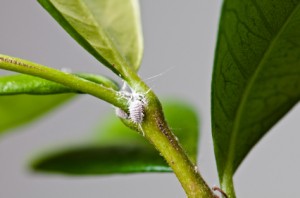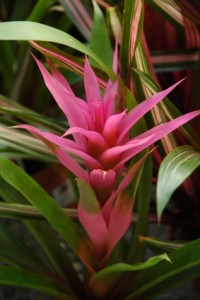How to Rid Your Bromeliad of Mealybugs
Author: Melanie Dearringer2 Comments
Bromeliads experience few pests when they are grown indoors. Outdoor bromeliads are more susceptible to pests but most are kept controlled through the presence of natural predators. Mealybugs are one type of pest that can be particularly devastating to bromeliads. When properly identified and managed, a mealybug infested bromeliad collection can be salvaged.
Mealybugs

-Mealybugs
Mealybugs are a type of unarmored, soft scale. They feed on the sap of bromeliads by puncturing the living tissues on leaves and roots causing significant damage to the plant. They typically form colonies and appear as cottony masses on your bromeliad’s leaves or stem. Mealybugs excrete a sticky substance called honeydew that is left behind on your plant’s surface. This sweet honeydew is highly desired by ants. Often times, the presence of ants is an indication of a mealybug infestation.
Life Cycle
Mealybugs live in colonies and reproduce quickly. If the conditions are right, such as in a greenhouse, mealybugs can produce up to four generations in a year. Depending on the species, each mealybug female can produce between 50 and 200 offspring. Male mealybugs become winged when they are mature. They do not feed off the plants but exist solely to reproduce. Male mealybugs can sometimes be mistaken for fungus gnats. It is important to catch mealybugs quickly so that they can be removed easily. A small infestation is obviously much easier to manage than one that has covered a plant or spread to several plants.
Identifying a Mealybug Outbreak
There are several ways to identify a mealybug infestation. While hard scale usually appears as brown, yellow, or red dots; mealybugs appear as white cottony masses. Many mealybugs are covered in a waxy layer to protect their bodies. Their eggs are also covered with a waxy coating. This is what produces the appearance of the cottony masses. Another indicator of mealybugs includes a sticky substance on the plant’s leaves. This sticky substance, called honeydew, is excreted by mealybugs after they take up the sugary sap from the plant. The presence of ants is also another good indicator that mealybugs are making a meal of your bromeliad. Ants feed off the honeydew left by mealybugs and will even defend them from natural predators in order to protect and maintain their food source. If you have a mealybug infestation, your bromeliad’s leaves may begin to turn yellow and drop. The plant may experience distorted growth and the appearance of a black sooty mold may become present. If your plant is not thriving and you do not notice any white cottony patches on the leaves, lift the plant from its container and carefully check the roots for any mealybugs. Be sure to check crevasses where leaves come together and places on the plant that are not easily visible. Mealybug infestations may start out in these hard-to-see places.
Managing Mealybugs
There are few ways to manage and remove mealybugs from bromeliads. If the infestation is small, use a cotton swab to swipe the mealybugs with Isopropyl Alcohol. It is also a good idea to wash the plant with a strong water spray to remove any residual eggs from the plants.
If you raise bromeliads outdoors or in a greenhouse, biological controls can be used. Natural predators such as lady beetles can be introduced to control mealybug populations. Many outdoor pests are kept under control through the natural presence of these predators.

Another option is horticultural oils. These soaps and oils are not toxic and work by suffocating the mealybugs. However, it is usually necessary to make several applications because each mealybug must be touched by the soap or oil in order to be removed. It is also important to apply the soaps or oils in mild temperatures as extreme hot or cold could damage the plant.
As a last resort, chemical insecticides can be used to remove a mealybug infestation. Care must be taken as these chemicals can be harsh on plants and are toxic to people and pets. If used on an indoor plant be sure to spray the plant outside. Then find a place to quarantine the plant away from pets and children for several days. If used outdoors, chemical insecticides can also damage natural predator populations. This will make a future infestation even more difficult to control. Before you spray always consult a professional to ensure you are using a chemical that is safe for bromeliads, legal in your state, and to teach you how to handle the chemical properly.
If you have a plant that is severely infected, while other plants remain healthy, the most practical solution may be to remove and destroy the struggling bromeliad. This will protect other plants in your collection. While it is difficult to sacrifice a loved plant, it is much easier to sacrifice a single bromeliad than an entire collection of plants should the infestation spread. Once the infested plant is removed, be sure to keep a close watch on your remaining plants. Small colonies of mealybugs should be removed quickly if they were passed to a new plant.
Points to Remember
There are a few things to keep in mind as you care for your bromeliads and protect them from pests:
- Keep a watchful eye; mealybug populations do not explode overnight.
- Check the roots; mealybugs can live below the soil level too.
- Manual removal is the easiest and most practical control option; use a cotton swab of rubbing alcohol to swipe mealybug colonies.
- Follow up with a strong spray of water to remove any eggs.
- Use the utmost care if you choose to apply chemicals and always seek the advice of a professional.
Mealybugs are a common nuisance on bromeliads, but they don’t have to destroy your bromeliad collection. With a watchful eye and quick intervention your plants can easily survive mealybugs.
Sources
Mealybug, Wikipedia. <http://en.wikipedia.org/wiki/Mealybug>
Mizell, R.F., III. 1998. Management of scale insect pests of bromeliads. <http://BromeliadBiota.ifas.ufl.edu/scalecontrol.htm>
Frequently Asked Questions, Bromeliad Society International. <http://www.bsi.org/brom_info/FAQ.html>
Cox, Jennifer. Lontailed Mealybug Life Cycle, HortFact. <http://www.hortnet.co.nz/publications/hortfacts/hf401032.htm>
2 Responses to “How to Rid Your Bromeliad of Mealybugs”
Leave a Reply

Resource Download
Hechtia Care Cheat Sheet
Learn how to care for your Hechtia bromeliad with this quick and easy informational guide.
Learn More
Ask an Expert
Questions about bromeliads?
Our experts love a challenge!
Photo of the Week
Submit your photo to be featured on the blog!
More Photo of the Week Winners
Submit Photo








HI, My Bromeliad has white powdery things in some of the soil, can i soke it in the soap? What can I do to save it? I only have one Bromeliad. Thanks Carolyn.
Why do I get little black worms that come out of my bromeliads?